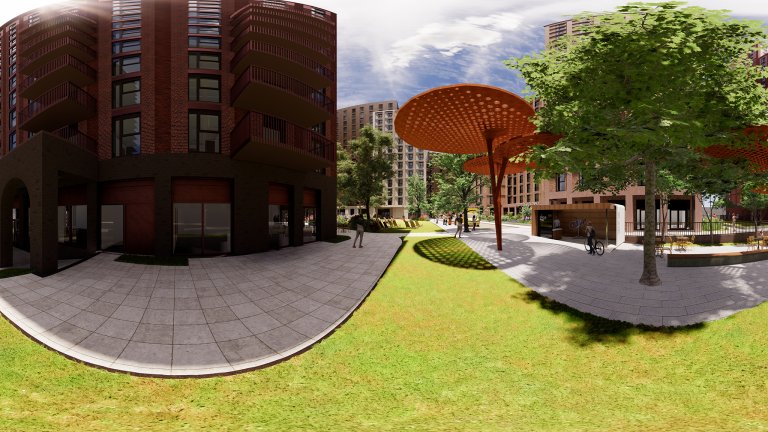
One of our key responsibilities as designers is to communicate. Architectural outputs are consumed by a broad range of audiences, from the client to stakeholders and the general public, and the challenge is always to communicate the message clearly – the image is the vehicle to put the point across. We enjoy this process – of choosing the medium and considering how to present it – one of our strengths as a practice is providing the right visual information for the right audience, at the right time.
Virtual-reality, whilst not new, is still relatively underused in architecture – but we feel the potential to support our work as communicators is huge.
Take our project LCV, for example – a 1000-home masterplan set around an extensive new network of parklets and public realm. The proposals are modelled in full in Revit, making it perfect to explore virtually. Using stereo (360°) parnoramic exports from the model, we can stitch together a gallery, creating a Google Streetview-style tour around the site, transporting the viewer between hotspots within the site, viewable in your browser, on the phone, and using a VR headset.
The obvious advantage is allowing clients, building users and the public the opportunity to experience the proposals in a far more immersive way. It can sell a proposal, generate interest and captivate an audience.
We, however, believe the potential is greater than this.
VR in Design
We think the use of VR should extend to consultation and to source feedback from stakeholders in a more efficient way; it makes our architecture more accessible to people for whom plans and elevations are difficult to digest. As the sense of a project is more readily communicated and experienced in the 3D environment, viewers may have a more immediate response to what they like and what they don’t – and crucially, what works.
As designers, VR is a tool for us too. It allows us to test ideas in the round, to review progress and to appraise the overall effectiveness of an approach. How is the proposal responding to it’s context? Can changes be made which increase light penetration in to the site, or does a window design need to be reconsidered to permit greater views or improve privacy? Our teams review the model collectively, casting views to larger screens, mirroring what the VR user is seeing and providing the opportunity for collective design review.
There can be a great deal of subjectivity – and indeed skepticism – around architectural visuals. Particularly with CGIs, there is an often made point during consultation that computer visuals, sometimes with highly selective angles and perma-clear skies, cannot necessarily be trusted. In the 3D environment you may still control the climate and the materials you apply, but there is less room to control the view. To that end, it has the capacity to be a more honest medium – and a critical design tool.
If you’re interested in using VR on your project – or merely want to try it – let us know, and we can bring the headset to you for a demonstration.
LCV TOUR
Experience our LCV project in 3D below. “Next” will take you to the next hotspot in the series, and “previous” to the last.
